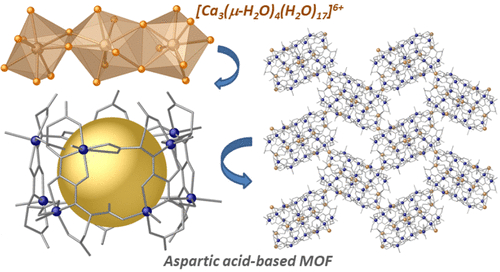Achieving a precise control of the final structure of metal−organic frameworks (MOFs) is necessary to obtain desired physical properties. Here, we describe how the use of a metalloligand design strategy and a judicious choice of ligands inspired from nature is a versatile approach to succeed in this challenging task. We report a new porous chiral MOF, with the formula Ca5II{CuII10[(S,S)-aspartamox]5}·160H2O (1), constructed from Cu2+ and Ca2+ ions and aspartic acid-decorated ligands, where biometal Cu2+ ions are bridged by the carboxylate groups of aspartic acid moieties. The structure of MOF 1 reveals an infinite network of basket-like cages, built by 10 crystallographically distinct Cu(II) metal ions and five aspartamox ligands
acting as bricks of a tubular motif, composed of seven basket-like cages each. The pillared hepta-packed cages generate pseudo-rhombohedral nanosized channels of ca. 0.7 and 0.4 nm along the b and a crystallographic axes. This intricate porous 3D network is anionic and chiral, each cage displaying receptor properties toward three-nuclear [Ca3(μ-H2O)4(H2O)17]6+ entities. 1 represents the first example of an extended porous structure based on essential biometals Cu2+ and Ca2+ ions together with aspartic acid as amino acid. 1 shows good biocompatibility, making it a good candidate to be used as a drug carrier, and hydrolyzes in acid water. The hypothesis has been further supported by an adsorption experiment here reported, as a proof-of-principle study, using dopamine hydrochloride as a model drug to follow the encapsulation process. Results validate the potential ability of 1 to act as a drug carrier. Thus, these make this MOF one of the few examples of biocompatible and degradable porous solid carriers for eventual release of drugs in the stomach stimulated by gastric low pH.

